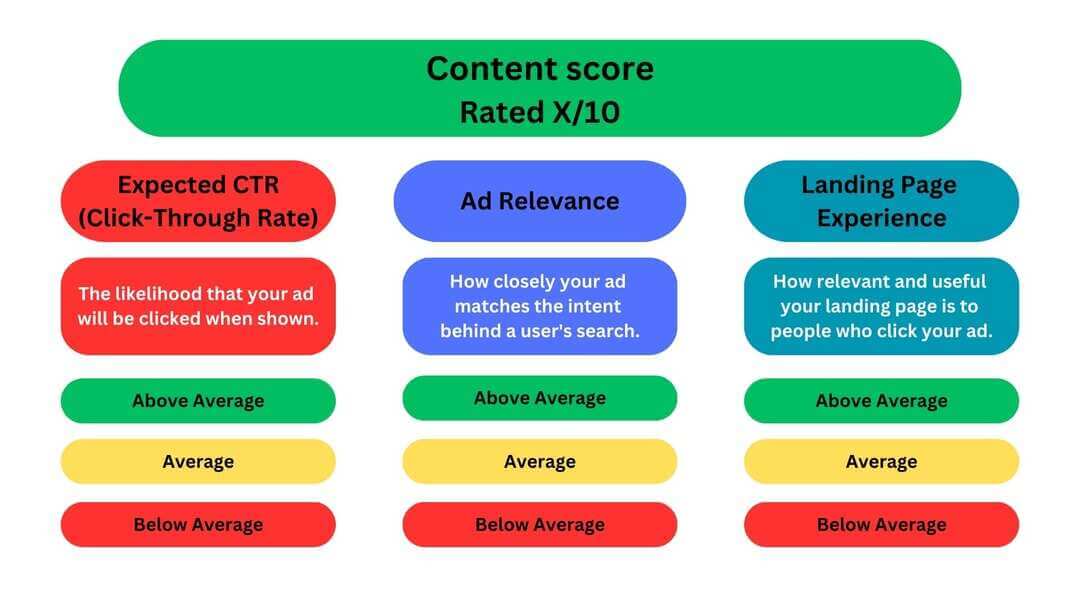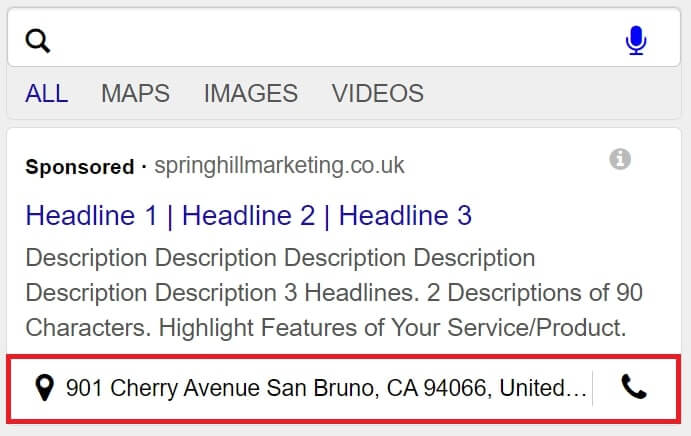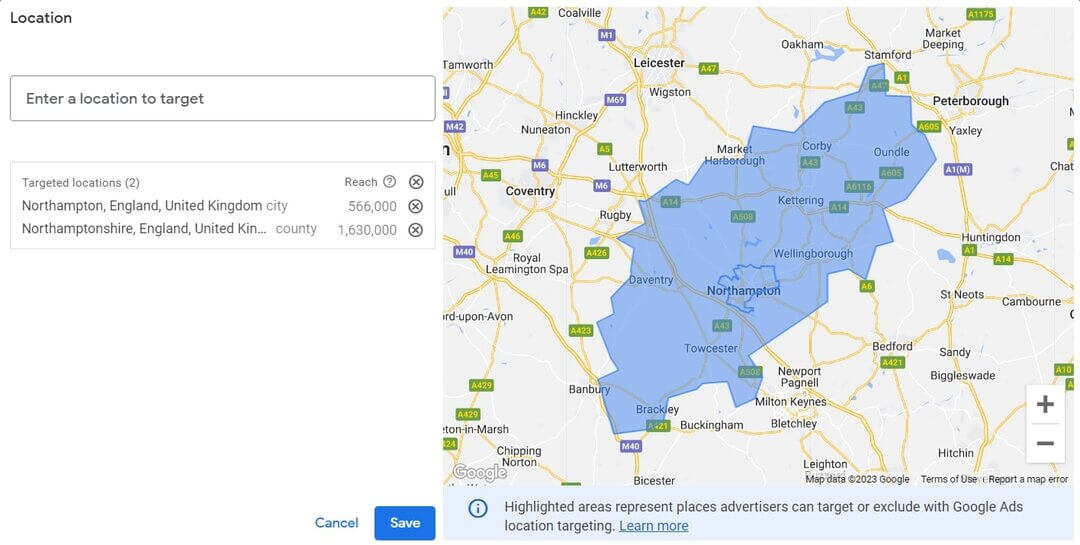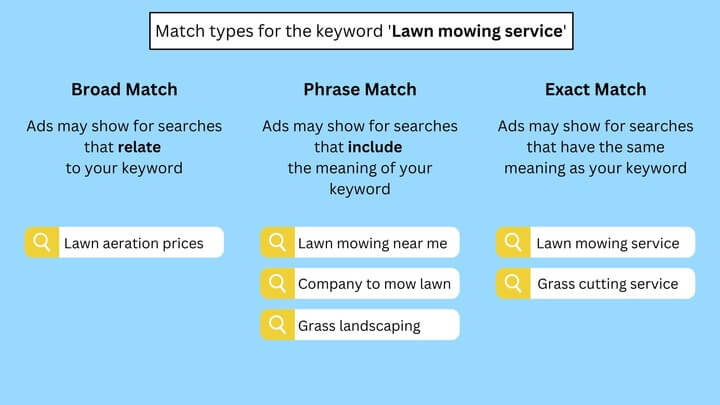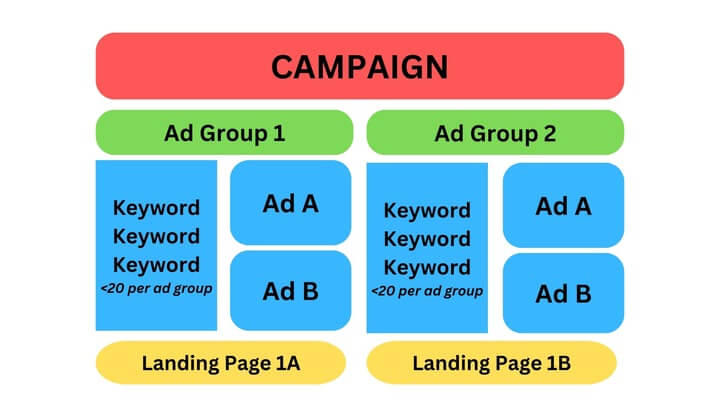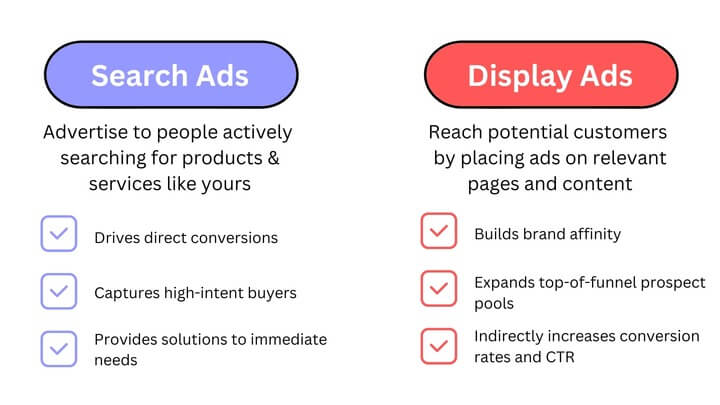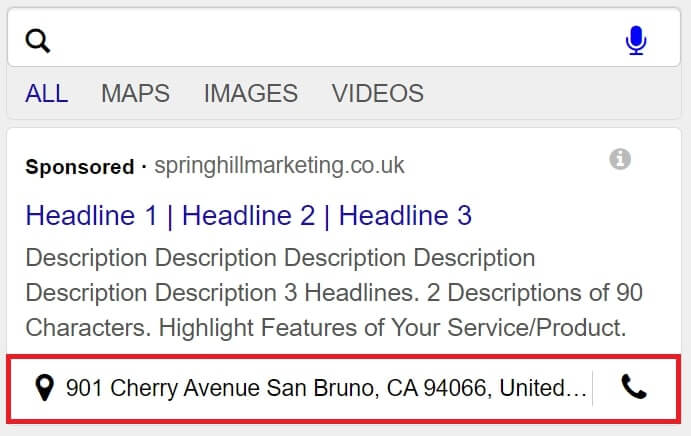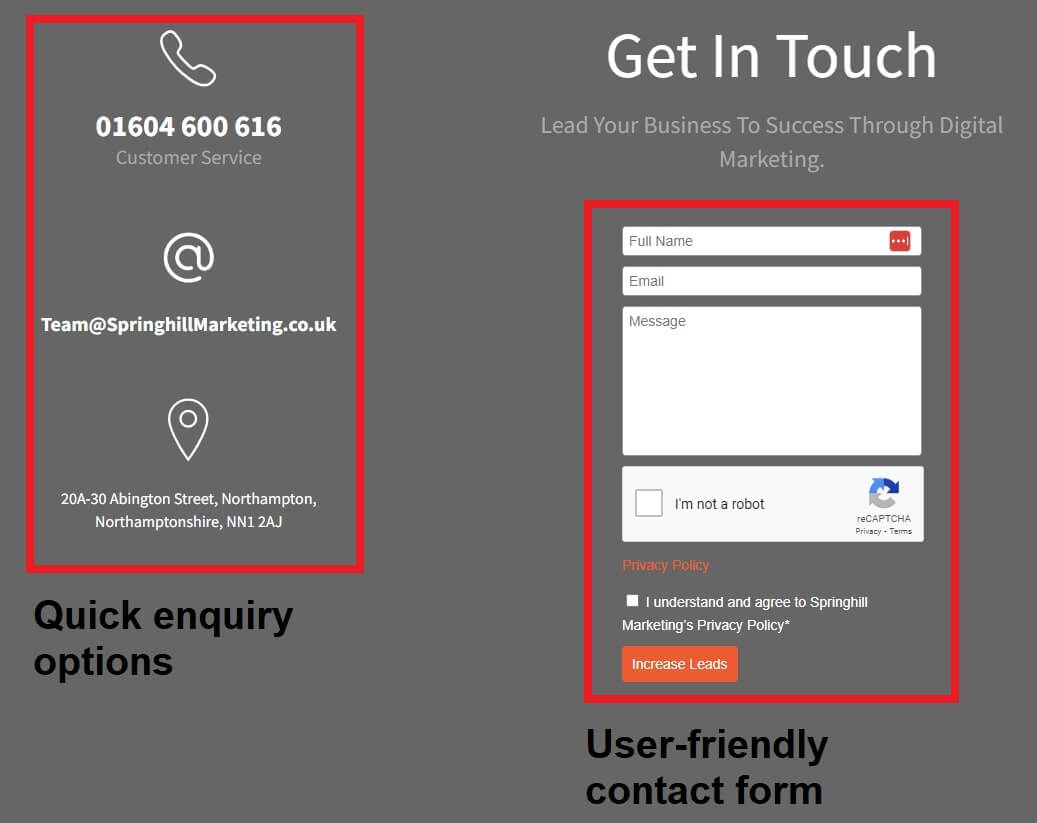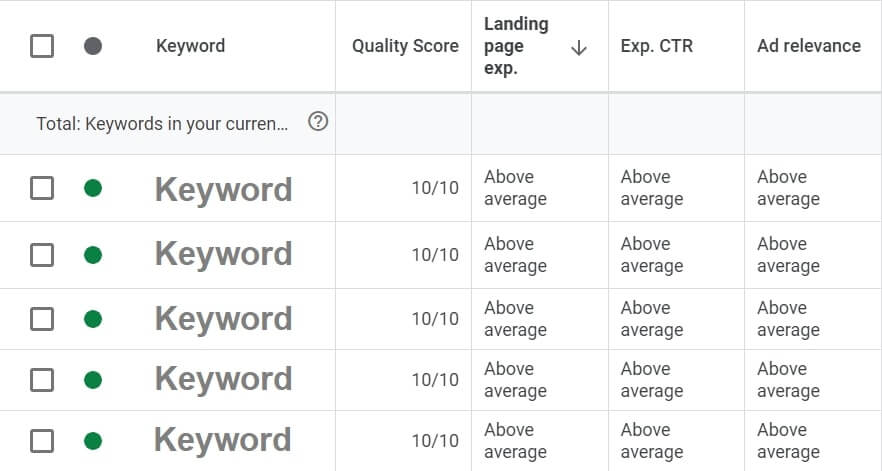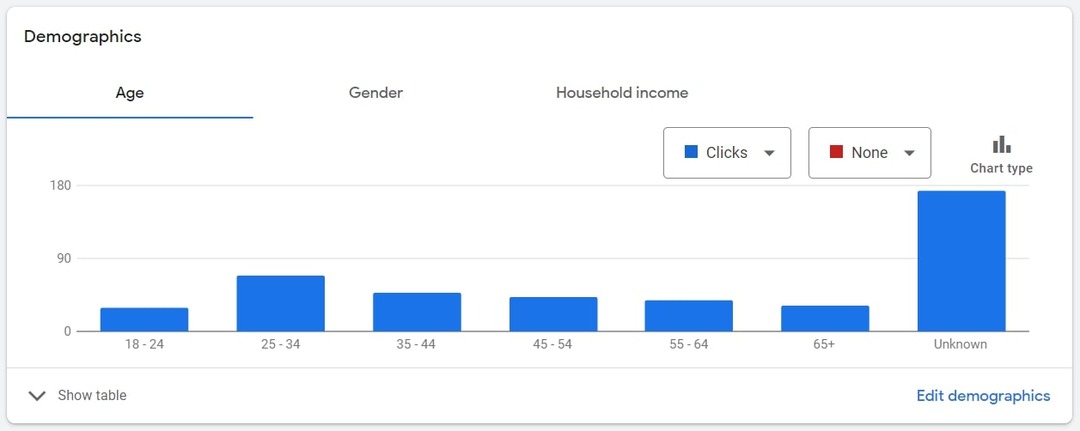From Lists to Leads: Data-Driven Decision-Making with Google Ads Customer MatchData-driven marketing is a realm where understanding your customer is more than a goal. It’s a fundamental necessity. In this blog, we're diving deep into how you can transform mere lists...

From Lists to Leads: Data-Driven Decision-Making with Google Ads Customer Match
From Lists to Leads: Data-Driven Decision-Making with Google Ads Customer Match
Data-driven marketing is a realm where understanding your customer is more than a goal. It’s a fundamental necessity. In this blog, we’re diving deep into how you can transform mere lists into valuable leads, guiding you through making informed, data-driven decisions with a tool that stands out in digital marketing.
Businesses are swamped with data, yet converting this data into actionable insights is the real challenge. This is where Google Ads Customer Match comes into play, helping your business understand your customers better, predict trends, and make smart and profitable decisions
Understanding Customer Match Marketing
Customer Match is a feature within Google Ads that enables you to use your online and offline data to reconnect with your customers across Search, Shopping, YouTube, and Gmail. By uploading a list of customer contact details into your Google Ads account, you can customise your marketing campaigns to target your customer base.
You need to understand how Customer Match works. Firstly, it’s crucial to have a good quality customer data list. This can include email addresses, phone numbers, or physical addresses. Google uses this information to match your customers with Google users.
Your ads can then be customised to these users, ensuring that your message reaches an audience familiar with your brand.
The Benefits of Customer Match
1. Improved Targeting
Customer Match allows for more precise targeting. By focusing on people who have interacted with your business, you will likely see a higher engagement rate.
2. Personalised Campaigns
With Customer Match, you can create personalised ad experiences that resonate with your audience. Tailoring your message to meet your customers’ specific needs and preferences can significantly boost conversion rates.
3. Increased Customer Retention
Keeping your brand at the top of your customer’s minds is essential for retention. Customer Match makes it easier to re-engage past customers with new offers, products, or content, encouraging repeat business.
4. Insightful Reporting
Understand how you’re performing with detailed reports. Analysing this data can provide you with insights into customer behaviour and campaign effectiveness.
5. Cross-Platform Reach
Google’s extensive network means you can engage with your customers wherever they are online, be it searching on Google, watching videos on YouTube, or checking emails on Gmail.
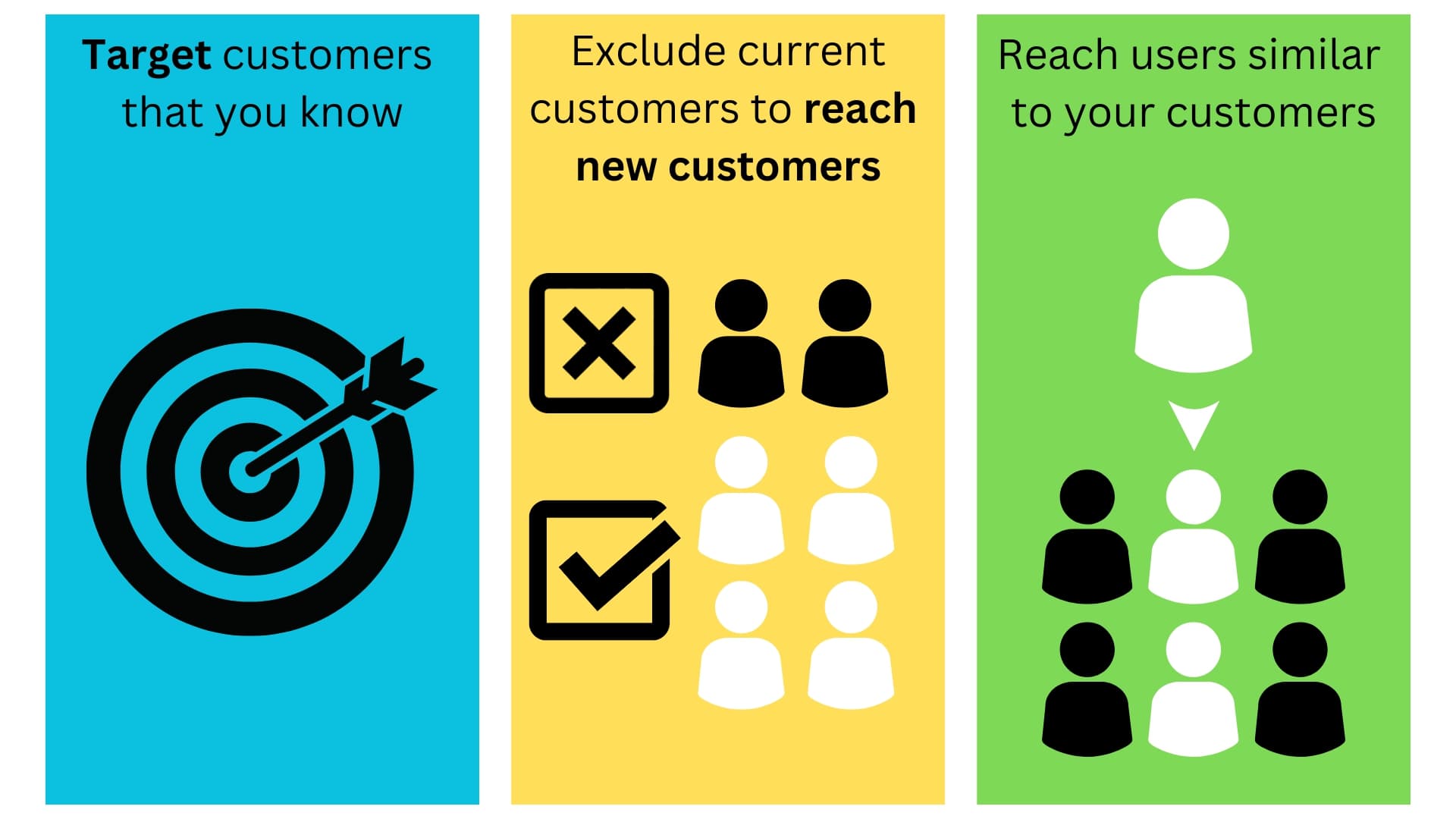
Implementing Customer Match in Your Strategy
It’s crucial to integrate Customer Match thoughtfully into your broader marketing strategy. This means segmenting your customer lists based on relevant criteria such as past purchase behaviour or engagement level. Also, continually testing and refining your campaigns based on performance data is key to maximising your return on investment.
The Mechanics of Customer Match in Google Ads
Customer Match uses your customer data to match people across Google’s products. Here’s a step-by-step breakdown of how you can set it up and start reaping the benefits:
1. Prepare Your Customer Data
Compile a list of your customers’ information. This can include email addresses, phone numbers, and physical addresses. Ensure this data is clean and up-to-date for the best matching results.
2. Upload to Google Ads
You can add this data to your Google Ads account through a secure and encrypted upload process. Google then uses this information to find the corresponding users across its platforms.

3. Create Targeted Campaigns
Once your list is uploaded and matched, you can create and run ad campaigns targeting this audience. You can also create similar audiences to reach new customers who share characteristics with your Customer Match list.
4. Customise Your Ads
Tailor your ad content to speak directly to the customer’s needs and preferences based on what you know about them. This level of personalisation can significantly improve engagement and conversion rates.
Security and Privacy
Now, let’s address the elephant in the room: security and privacy. In an age where data breaches are all too common, it’s natural to be concerned about the safety of your customer data. Here’s how Google ensures that your information, and that of your customers, is handled responsibly:
1. Data Encryption
When you upload your data to Google Ads, it’s encrypted to keep it secure. Google also uses a hashing process to anonymise the data, adding an extra layer of security.
2. User Anonymity
Google matches the data you provide with its users to preserve user anonymity. You won’t know who has been matched, but your ads are reaching the intended audience.
3. Control for Users
Users have control over the ads they see. They can opt out of personalised ads, giving them autonomy over their online experience.
4. Adherence to Policies
Google has strict policies about what data types are allowed for Customer Match. Ensure you’re familiar with these to maintain compliance and protect your customers’ privacy.
Setting Up for Success: Preparing for Customer Match
Before you can start using Customer Match, there are a few boxes you’ll need to tick. Understanding these requirements will ensure your campaigns run smoothly and comply with Google’s policies.
1. Google Ads Account
Naturally, you’ll need an active Google Ads account. If you still need one, setting it up is straightforward and free.
2. Customer List Size
Google requires a minimum number of customers on your list for Customer Match to work effectively. This ensures that your targeting is accurate and maintains user privacy.
3. Policy Compliance
Your use of Customer Match must comply with Google’s Customer Match policies, which include guidelines on the type of data you can use and how you can collect it. Familiarise yourself with these policies to avoid any hiccups.
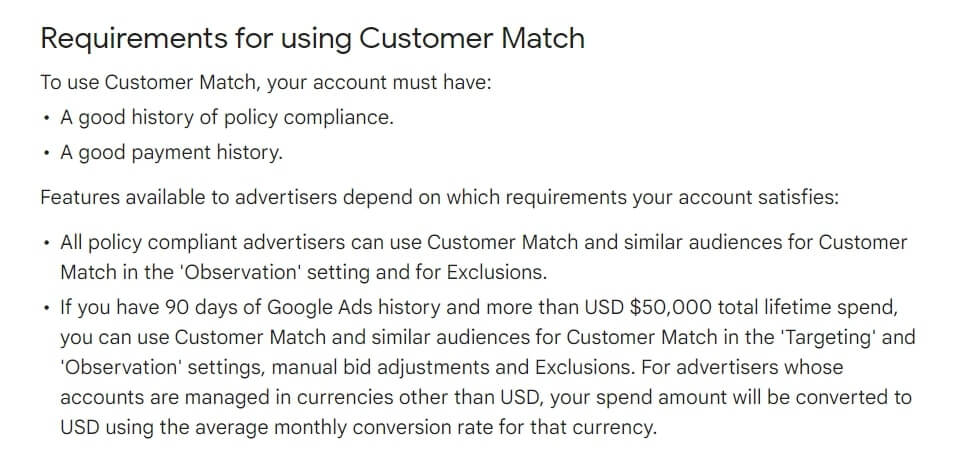
4. Account History and Performance
Google might review your account’s history and performance before allowing you to use Customer Match. This is to ensure that advertisers meet specific standards in their advertising practices.
Creating a Customer Data File
The backbone of your Customer Match efforts is your customer data file. Here’s how to create one that’s both effective and compliant:
1. Collect Customer Information
Gather information from your customers with their consent. This can include email addresses, phone numbers, and physical addresses. Make sure you’re transparent about how you’ll use this data.
2. Format Your Data
Google requires that you format your data in a specific way for uploading. Typically, this involves creating a plain text file with one piece of information per line. Check Google’s latest format requirements to ensure compatibility.

3. Clean and Update Your Data
Regularly clean your customer list to remove any outdated or incorrect information. This will improve the matching process and the effectiveness of your campaigns.
4. Segment Your List
Consider segmenting your customer data into lists based on criteria like purchase history or engagement level. This allows for more targeted and personalised advertising.
5. Stay Privacy-Focused
Always prioritise your customers’ privacy. Ensure you have their consent to use their data and be transparent about your privacy practices.
Implementing Customer Match in Your Campaigns
Implementing Customer Match in your Google Ads campaigns can significantly enhance your marketing efforts. Consider this step-by-step guide.
1. Check Your Eligibility
Before you start, ensure that your Google Ads account is eligible for Customer Match. You’ll need to meet specific requirements regarding your account’s history and spending.
2. Collect Customer Data
Gather the information you need from your customers. This includes email addresses, phone numbers, and physical addresses. Remember, the quality of your data directly affects the success of your match.
3. Create a Customer Data File
Format your customer data file correctly. Google provides specific guidelines on how to structure this file. Ensuring accuracy here will help in maximising match rates.
4. Upload Your Data
Go to your Google Ads account and upload your customer data file. This process is secure and respects user privacy. Once uploaded, Google will begin matching this data with its users.
5. Create Your Campaigns
With your audience defined, you can create campaigns targeting your Customer Match audience through search, shopping, YouTube, or Gmail.
6. Monitor and Adjust
Once your campaign is live, monitor its performance closely. Use the data you gather to adjust your targeting, bid strategies, and ad content.
Tips for Segmentation and Targeting
1. Understanding Your Audience
Divide your customer list into meaningful segments based on their behaviour, purchase history, or other relevant criteria. This allows for more personalised and effective targeting.
2. Tailored Messaging
For each segment, create tailored messages that resonate with that group’s specific needs and interests. Personalised ads tend to have higher engagement and conversion rates.
3. Test and Learn
Experiment with different segmentation strategies and ad messages. Use A/B testing to understand what works best with your audience and refine your approach based on real data.
4. Use Similar Audiences
Extend your reach by targeting similar audiences. These are users that Google identifies as having similar characteristics to your Customer Match audience.
5. Privacy First
Always respect privacy and consent. Ensure your data collection and usage comply with all relevant laws and Google’s policies.
6. Keep Data Fresh
Regularly update your customer data file to reflect the most current information. This ensures that your targeting remains accurate and effective.
Optimising Campaigns and Measuring Success
This stage is where the art and science of marketing come together, turning good campaigns into great ones.
Refining Your Audience
1. Continuous Learning
Understand that your first audience list isn’t your last. As you gather more data on how your audience interacts with your ads, continually refine and update your list to match your ideal customer profile.
2. Segmentation Strategies
The more tailored your segments are, the more personalised and effective your campaigns can be. Consider segmenting by lifecycle stage, past purchase behaviour, or engagement level.
3. Re-engagement Tactics
For those who didn’t convert, consider why. Was it the messaging, timing, or something else? Use Customer Match to re-engage these users with different messaging or special offers.
4. Expand with Similar Audiences
Use the insights gained from your Customer Match campaigns to explore similar audiences. This can help you reach new prospects who are likely to be interested in your products or services based on their similarities to your best customers.
Key Metrics to Track
1. Conversion Rate
This is the bread and butter of campaign success metrics. Are the users you’re targeting taking the desired action? If you still need to, it’s time to revisit your audience segments or the campaign message.
2. Click-Through Rate (CTR)
A high CTR indicates that your ads are relevant and compelling to your audience. Consider refining your ad copy or creative elements if your CTR needs to be higher.
3. Cost Per Acquisition (CPA)
Monitoring your CPA helps ensure you’re spending less to acquire a customer than they’re worth. Continuously optimise your campaigns to lower your CPA while maintaining or increasing the quality of conversions.
4. Customer Lifetime Value (CLV)
Understand the long-term value of the customers you’re acquiring. This will help you make informed decisions about how much you’re willing to spend to acquire similar customers.
5. Retention Rate
Particularly important for re-engagement campaigns, the retention rate will tell you if you successfully bring back past customers and keep them engaged over time.
Navigating Challenges and Common Questions
There are often concerns and questions along the way. Let’s demystify these aspects to pave the way for a smoother, more successful marketing journey.
1. How does Google ensure the confidentiality of your customer data?
Google encrypts all data and uses a hashing method to match customers without revealing their identities. Always ensure you comply with data protection laws like GDPR or CCPA.
2. What if the data doesn’t accurately match my customers?
While no system is infallible, Google continues to refine its matching algorithm for accuracy. You can improve match rates by regularly updating your customer lists and ensuring the data is as complete and accurate as possible.
3. How do you ensure your ads remain relevant and don’t lead to ad fatigue?
The key is in continuous monitoring and updating. Regularly refresh your ad creatives, fine-tune your messages, and segment your audiences to ensure they receive relevant, engaging content.
4. Google Ads seems complex; how do I manage it effectively?
The platform has a wealth of features, but abundant resources, from online tutorials to forums, can help you navigate. Consider also leveraging the expertise of a digital marketing professional such as Springhill Marketing.
5. How do I truly know if Customer Match is working?
Look at the broader impact beyond the usual metrics like click-through and conversion rates. Are you seeing increased customer loyalty, higher lifetime value, or improved brand recognition?
Looking Ahead: The Future of Data-Driven Marketing with Customer Match
It’s crucial to look ahead and understand the potential developments and shifts that will shape the future. Customer Match is at the forefront of these changes, offering a glimpse into a more targeted, efficient, and user-centric marketing world.
Emerging Trends and Enhancements
1. Enhanced Machine Learning
As machine learning algorithms become more sophisticated, expect Customer Match to offer more precise targeting and prediction capabilities. This means understanding customer behaviours, predicting future actions, and personalising content to an unprecedented degree.
2. Integration with More Platforms
While currently available on platforms like Search, YouTube, Gmail, and Shopping, the future might integrate with even more Google services and third-party platforms, offering a more holistic view of the customer journey.
3. Improved Audience Insights
Anticipate richer, more detailed insights into your audience segments. Understanding not just who your customers are but predicting what they want, need, and feel will be the cornerstone of successful marketing strategies.
4. Automation and Efficiency
As tools and platforms become more intuitive and automated, marketers will spend less time on manual campaign adjustments and more time strategising and creating. This means more efficient campaigns with higher ROI.
5. Cross-device and Cross-Channel Marketing
The future is seamless. Customer Match might evolve to offer even more robust cross-device and cross-channel capabilities, ensuring you can reach your customers with the right message, no matter where or what device they use.
The Evolving Role of Data Privacy
1. Stricter Regulations
As concerns about user privacy grow, so will the data usage regulations. Expect tighter controls and more transparent policies, ensuring users’ data is handled responsibly and ethically.
2. Consent-Based Marketing
The future will likely emphasise consent-based marketing practices, where users have more control over what data they share and how it’s used. This shift will require marketers to be more innovative and respectful in their approaches.
3. Anonymisation and Security
Advanced data anonymisation and encryption techniques will become the norm, ensuring that personal data remains secure and private. This will be crucial in maintaining user trust and complying with regulations.
4. User Empowerment
Users will have more insight and control over their data, including how it’s collected and used. This will change how marketers approach data collection and usage, focusing on transparency and user benefits.
5. Ethical Data Use
Expect a greater focus on ethical data use, where companies comply with laws and adhere to moral standards in their data practices. This will be a key factor in brand reputation and customer loyalty.
The emerging trends and the evolving role of data privacy will guide this journey, creating a marketing landscape that is more efficient, ethical, and effective.
Conclusion
Understanding and leveraging tools like Customer Match is a necessity. By embracing this tool, you can set trends and reach customers while understanding and growing with them.
At Springhill Marketing, we commit to harnessing the potential of Google Ads Customer Match for your benefit. We’re dedicated to guiding you through the process, enhancing your brand awareness, and optimising your return on investment through this powerful tool.
If you want to run a successful and efficient Google Ads campaign utilising Customer Match, don’t hesitate to contact us.
Drive Your Business Towards The Best Results.
Talk to us about how we can help.











